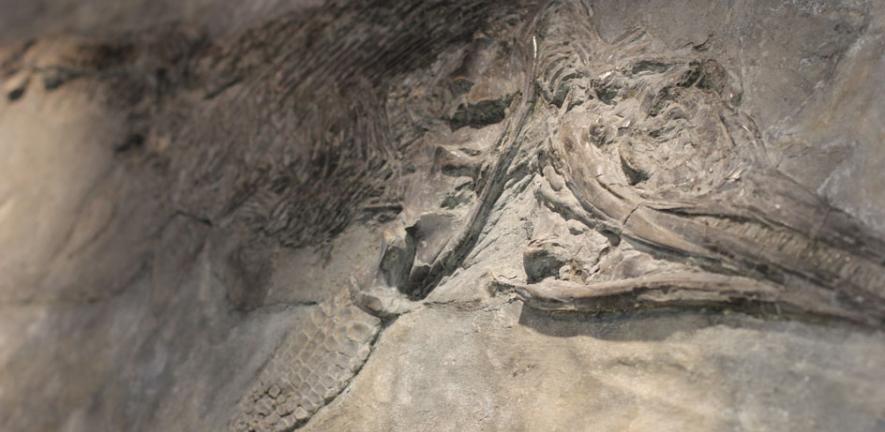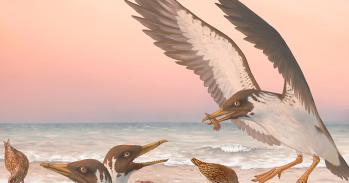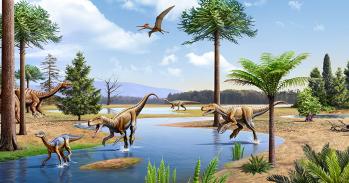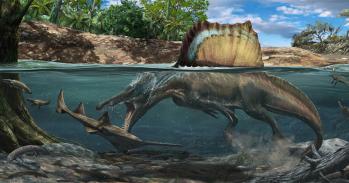
Mary Anning’s fossil discoveries revealed an ‘ancient Dorset’, and were influential contributions to the blossoming science of palaeontology during the early 19th century.
Mary Anning’s fossil discoveries revealed an ‘ancient Dorset’, and were influential contributions to the blossoming science of palaeontology during the early 19th century.
What is it?
This is the fossil skeleton of an ichthyosaur, a type of extinct marine reptile. It lived during the early Jurassic Period, and is around 200 million years old. The fossil was found in the cliffs at Lyme Regis in Dorset in 1835 by celebrated fossil collector Mary Anning.
What’s the story?
The ichthyosaur fossil was purchased from Mary Anning by Cambridge geologist and Woodwardian Professor Adam Sedgwick. Sedgwick’s desire to expand the University’s geological collections meant he was well connected with many of the fossil collectors of the time. A series of letters between Anning and Sedgwick during the summer of 1835 has enabled us to trace the history of this specimen.
A letter from Anning to Sedgwick, delivered by the hand of a Lyme clergyman who happened to be visiting Cambridge, dated 29 June 1835, first roused Sedgwick’s interest in the fossil. In the letter Anning describes it as ‘a perfect Ichthyosaurus about four feet and a half long’. Along with this specimen she mentions two other fossil ichthyosaurs for sale, as well as some fossil crinoids (sea-lilies). Noticeably, and perhaps shrewdly, Anning did not mention the price of any of the specimens in this letter.
Sedgwick replied on 24 July, to which Anning wrote back detailing the prices of some of the fossils, specifying that the price of the Ichthyosaur specimen was £50.
Although there is no known letter confirming Sedgwick’s interest in the specimen at the stipulated price, a letter from Anning to Sedgwick dated 9 September confirms that she ‘sent off the Ichths [sic] on Tuesday 2nd of September on board the Unity, Pearce Mastr’. She also sent a letter, dated 23 September, acknowledging receipt of an order for £50.
In 1835 the University of Cambridge Senate appointed a syndicate to solicit subscriptions for a new library with museums and lecture rooms beneath it. Sedgwick evidently had grand ambitions for a geological museum from the outset. He contributed 100 guineas of his own money to the subscription and purchased expensive specimens such as this ichthyosaur and the skeleton of a giant Irish deer.
Sedgwick’s geological museum opened in the Cockerell Building (now the Squire Law Library) in about 1842 where the ichthyosaur would have been on display until it was moved to the newly built Sedgwick Museum in about 1904.
The fossil was redisplayed in the Museum’s ‘Jurassic Seas’ exhibition in 1998. It shares its current display case with another ichthyosaur, discovered by Thomas Hawkins, also an important 19th century fossil collector.
Can we see it?
This ichthyosaur is one of several spectacular marine reptile fossils that the Sedgwick Museum has on permanent display in its galleries. The Museum is open 10-1 and 2-5 weekdays and 10-4 on Saturdays.
Want to know more?
To find out more about the Sedgwick Museum and its collections, visit us or look up the website at https://sedgwickmuseum.cam.ac.uk/, blog http://sedgwickmuseum.org.uk/blog/, and find us on Facebook https://www.facebook.com/sedgwickmuseum
Mary Anning’s life and work is the subject of the book ‘Jurassic Mary: Mary Anning and the primeval sea monsters’ by Patricia Pierce, and also forms the basis for the novel ‘Remarkable Creatures’ by Tracy Chevalier.
This work is licensed under a Creative Commons Licence. If you use this content on your site please link back to this page.





